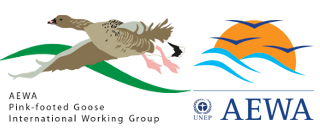Current Size: 76%
The Pink-footed Goose
The Pink-footed Goose or “pinkfoot” (Anser brachyrhynchus) is classified as having a “Favourable Conservation Status” within Europe and is ranked as a species of Least Concern according to IUCN’s global Red List criteria. Two bio-geographical populations occur: the Iceland/East Greenland population and the Svalbard population.
Although the continued growth of the Svalbard population is a conservation success story, its increasing size has progressively brought the geese into conflict with agricultural interests causing considerable economic costs. Furthermore, there is also concern about the degradation of vulnerable tundra vegetation in Svalbard due to increased grazing by the growing numbers of pink-footed geese.
In order to ensure the sustainable management of the Svalbard Pink-footed Goose population the first management Plan under the African-Eurasian Migratory Waterbird Agreement (AEWA) was adopted for the species in 2012. The AEWA Pink-footed Goose International Working Group, which consists of representatives from the four range states for the Svalbard population (Belgium, Denmark, the Netherlands and Norway) as well as observers, coordinates the implementation of the Svalbard Pink-footed Goose (SPfG) International Species Management Plan (ISMP).














